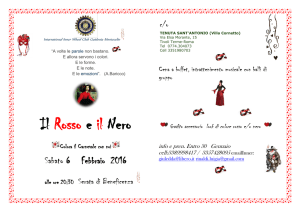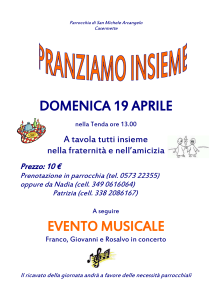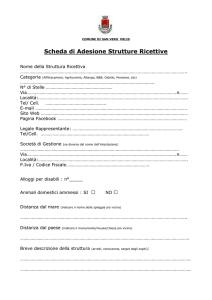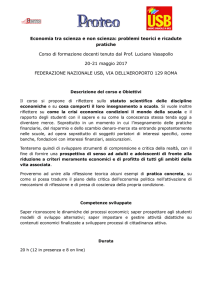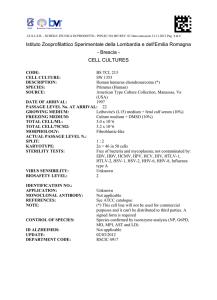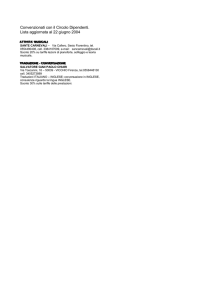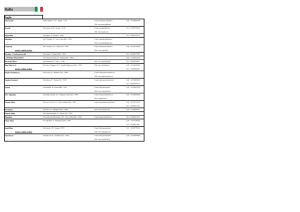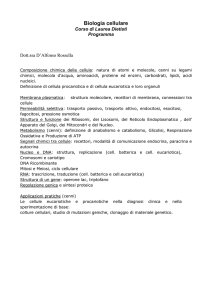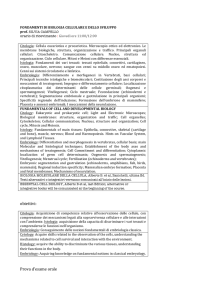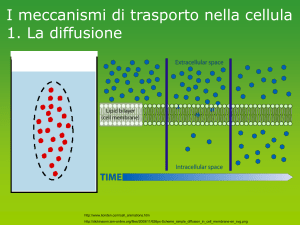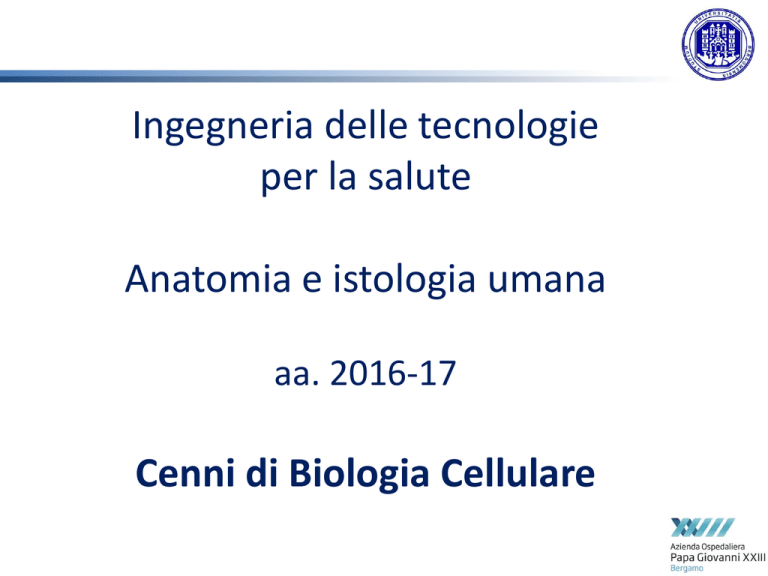
Ingegneria delle tecnologie
per la salute
Anatomia e istologia umana
aa. 2016-17
Cenni di Biologia Cellulare
human body is composed of elements, like matter…
Organic compounds essential to human functioning
include carbohydrates, lipids, proteins, and
nucleotides.
said organic because they contain both carbon and
hydrogen.
monomers are single units of organic compounds: they
bond by dehydration synthesis to form polymers,
which can in turn be broken by hydrolysis.
Macromolecules for human life
CARBOHYDRATES
Carbohydrate compounds provide essential
body fuel.
Their structural forms include
monosaccharides such as glucose, disaccharides
such as lactose, and polysaccharides, including
starches (polymers of glucose), glycogen (the
storage form of glucose), and fiber.
All body cells can use glucose for fuel. It is
converted via an oxidation-reduction reaction
to ATP.
monosaccharides
5 monosaccaridi importanti per l’uomo: glucosio, fruttosio, galattosio,
desossiribosio, ribosio
Scheletro carbonioso, 5-6 C
Solubili in acqua
Disaccharides & polysaccharides
Disaccaridi e polisaccaridi
Legame 1α4 e 1α6-glicosidico:
digeribile
Legame β glicosidico: non
digeribile
Funzione di riserva energetica:
glicogeno
α
hydrolysis
β
CARBOHYDRATES
Funzioni:
•Struttura: acidi nucleici
•Energia: impiegati come combustibile e fonte di
energia (4 Kcal/g)
•Componenti aggiuntivi proteine
•Introdotti con la dieta
•Formati ex-novo a partire da aminoacidi
(gluconeogenesi)
•Riserva in fegato e muscoli come glicogeno
LIPIDS
= hydrophobic compounds, providing body fuel and
important components of many biological
compounds.
Triglycerides = most abundant in the body,
composed of a glycerol backbone attached to 3
fatty acid chains.
Phospholipids = composed of a diglyceride with a
phosphate group attached at the molecule’s head,
resulting in a molecule with polar and nonpolar
regions.
Steroids = lipids formed of 4 hydrocarbon rings
(most important cholesterol).
Prostaglandins = signaling molecules derived from
unsaturated fatty acids.
Triglycerides
Molecole apolari, insolubili in acqua. Catena carboniosa variabile
Famiglia di macromolecole:
Acidi grassi e trigliceridi
Alcuni sono essenziali (non
sintetizzabili dall’organismo)
(linoleico-arachidonico)
Phospholipids Steroids Prostaglandins
Steroidi e
colesterolo
Fosfolipidi
glicolipidi
Acido grasso apolare
Testa polare
PO4
Zucchero
Phospholipids Steroids Prostaglandins
LIPIDS
•Funzione strutturale: membrane
•Funzione energetica 9Kcal/g (depositi nel
tessuto adiposo)
•Funzione ormonale: ormoni steroidei
PROTEINS
Proteins are critical components of all
body tissues, made up of monomers
called amino acids, which contain
nitrogen, joined by peptide bonds.
Protein shape is critical to its function.
Most body proteins are globular. An
example is enzymes, which catalyze
chemical reactions.
PROTEINS
Proteine
polipeptidi
20 aminoacidi proteogenici
Aminoacidi non proteogenici
Proteine sintetizzate nell’organismo a partire da aminoacidi
in base al codice genetico
PROTEINS
proteine:
Struttura primaria: catena polipeptidica
Struttura secondaria: alfa-elica betafoglietto
Struttura terziaria: conformazione
tridimensionale
Struttura quaternaria: rapporto e legame
con altre proteine
PROTEINS
PROTEINS
Funzioni:
•Energetica, 4,5 Kcal/g
•Strutturale: citoscheletro e contrattilità
•Enzimi
•Canali e proteine di membrana
•Trasporto: albumina, Hb
•Ormoni
NUCLEOTIDES
= compounds with 3 building blocks: one
or more phosphate groups, a pentose
sugar, and a nitrogencontaining base.
DNA and RNA are nucleic acids that
function in protein synthesis.
ATP is the body’s fundamental molecule
of energy transfer. Removal or addition
of phosphates releases or invests
energy.
NUCLEOTIDES
Nucleosidi: zucchero+base azotata
Nucleotidi: zucchero+base azotata+fosfato
DNA: acido desossiribonucleico
(desossiribosio+base+fosfato) ATGC
RNA acido ribonucleico (ribosio+base+fosfato)
AUGC
Basi azotate:
Purine: Arginina e Guanosina
Pirimidine: Timidina, Citosina e Uracile
NUCLEOTIDES
NUCLEOTIDES
DNA: doppia
elica
Codice
genetico per
triplette
NUCLEOTIDES
NUCLEOTIDES
Funzioni:
•Codice genetico
•Trasporto: ATP-ADP-AMP trasportatore
energia, gruppo fosfato
•Sintesi proteica: mRNA rRNA tRNA
•Signaling intracellulare
Dna chimicamente identico per tutti i viventi
Jacques Monod
Jacques Monod (Parigi, 9 febbraio 1910 –
Cannes, 31 maggio 1976), biologo e
filosofo francese, vincitore del premio
Nobel per la medicina nel 1965 e membro
della Legion d'Onore ha elaborato sulla
base delle nuove scoperte scientifiche
una filosofia che cerca di risolvere
l'antico dualismo tra caso e necessità. La
nuova conoscenza scientifica del mondo,
comporterà anche la definizione di nuovi
valori etici.
Jacques Monod: rapporto con la filosofia
Nella prefazione a Il caso e la necessità :
«Oggi è poco prudente per un uomo di scienza inserire il termine 'filosofia',
sia pur 'naturale', nel titolo o nel sottotitolo di un'opera: è il miglior modo per
farla accogliere con diffidenza dagli scienziati, e, per bene che vada, con
condiscendenza dai filosofi. Ho un'unica scusante, che però ritengo legittima,
ed è il dovere che si impone agli uomini di scienza, oggi più che mai, di pensare
la propria disciplina nel quadro generale della cultura moderna, per arricchirlo
non solo di nozioni importanti dal punto di vista tecnico, ma anche di quelle
idee, provenienti dal loro particolar campo d'indagine, che essi ritengano
significative dal punto di vista umano. Il candore di uno sguardo nuovo (quello
della scienza lo è sempre) può talvolta illuminare di luce nuova antichi
problemi.»
Jacques Monod: Caso e necessità
Evoluzionisti e creazionisti
Ne L'origine delle specie (1859) Charles Darwin con la sua teoria
evoluzionistica sosteneva che le variazioni morfologiche degli esseri viventi
erano dovute alla casualità escludendo dalla considerazione della natura ogni
finalismo di un'azione provvidenziale di un Dio creatore.
Nasceva quindi una polemica con i cosiddetti creazionisti i quali rifiutavano una
spiegazione meccanicistica e naturalistica dello sviluppo della vita escludente
un qualsiasi intervento sovrannaturale.
Jacques Monod: “Il caso e la necessità” 1970
«[Le alterazioni nel DNA] sono accidentali, avvengono a caso. E poiché esse
rappresentano la sola fonte possibile di modificazione del testo genetico, a
sua volta unico depositario delle strutture ereditarie dell'organismo, ne
consegue necessariamente che soltanto il caso è all'origine di ogni novità, di
ogni creazione nella biosfera. Il caso puro, il solo caso, libertà assoluta ma
cieca, alla radice stessa del prodigioso edificio dell'evoluzione: oggi questa
nozione centrale della Biologia non è più un'ipotesi fra le molte possibili o
perlomeno concepibili, ma è la sola concepibile in quanto è l'unica compatibile
con la realtà quale ce la mostrano l'osservazione e l'esperienza. Nulla lascia
supporre (o sperare) che si dovranno, o anche solo potranno, rivedere le
nostre idee in proposito.»
Gli esseri viventi infatti rappresentano un sistema chiuso: essi sono
caratterizzati dall'"invarianza" e dalla "teleonomia" cioè dalla capacità di
trasmettere la propria struttura genetica alle generazioni successive.
Quando si verifica una mutazione questa è da ascrivere non ad un'impossibile
interazione con l'ambiente ma piuttosto con eventi casuali verificatisi al suo
interno: «Gli eventi iniziali elementari, che schiudono la via dell'evoluzione ai
sistemi profondamente conservatori rappresentati dagli esseri viventi sono
microscopici, fortuiti e senza alcun rapporto con gli effetti che possono
produrre nelle funzioni teleonomiche.»
Jacques Monod: “Il caso e la necessità” 1970
Tuttavia, dal momento in cui la modifica nella struttura del DNA si è verificata, una
volta avvenuta la mutazione «l'avvenimento singolare, e in quanto tale essenzialmente
imprevedibile, verrà automaticamente e fedelmente replicato e tradotto, cioè
contemporaneamente moltiplicato e trasposto in milioni o miliardi di esemplari. Uscito
dall'ambito del puro caso, esso entra in quello della necessità, delle più inesorabili
determinazioni. La selezione opera in effetti in scala macroscopica, cioè a livello
dell'organismo.»
Monod quindi opera una sintesi tra il caso che origina le mutazioni e il rigido
determinismo che opera nel meccanismo della selezione naturale nel momento in cui
l'essere vivente mutato si deve mettere alla prova con l'ambiente.
CELL
CELL
Cellula umana: EUCARIOTE (dotata di nucleo) eccetto
globuli rossi
10-50 μm, eccezioni: oocita, motoneuroni (circa 150 μm)
Tutte le cellule posseggono l’intero genoma.
Diverse funzioni
CELL MEMBRANE
Bilayer fosfolipidico
Impermeabile ai soluti
Permeabile ai gas
= barrier around the cell, separating its internal components
from the extracellular environment.
composed of a phospholipid bilayer, with hydrophobic
internal lipid “tails” and hydrophilic external phosphate
“heads.” Various membrane proteins are scattered
throughout the bilayer, both inserted within it and attached
to it peripherally.
CELL MEMBRANE
selectively permeable, allowing only a limited number of materials to diffuse
through its lipid bilayer. All materials that cross the membrane do so using passive
(non energy-requiring) or active (energy-requiring) transport processes.
During passive transport, materials move by simple diffusion or by facilitated
diffusion through the membrane, down their concentration gradient. Water passes
through the membrane in a diffusion process called osmosis.
During active transport, energy is expended to assist material movement across
the membrane in a direction against their concentration gradient. Active transport
may take place with the help of protein pumps or through the use of vesicles.
Proteine canale:
passaggio soluti
Colesterolo: fluidità
Proteine di membrana:
recettori
Cytoplasm and Cellular Organelles
internal environmental of a living cell is made up of a
fluid, jelly-like substance called CYTOSOL, which
consists mainly of water, but also contains various
dissolved nutrients and other molecules. The cell
contains an array of cellular ORGANELLES, each one
performing a unique function and helping to maintain
the health and activity of the cell.
cytosol + organelles = cell’s CYTOPLASM.
Cytoplasm and Cellular Organelles
Most organelles are surrounded by a lipid membrane similar to the
cell membrane of the cell. The ENDOPLASMIC RETICULUM (ER),
GOLGI APPARATUS, and LYSOSOMES share a functional
connectivity and are collectively referred to as the
ENDOMEMBRANE SYSTEM.
There are two types of ER: SMOOTH and ROUGH. While the
smooth ER performs many functions, including lipid synthesis and
ion storage, the rough ER is mainly responsible for protein
synthesis using its associated ribosomes. The rough ER sends
newly made proteins to the Golgi apparatus where they are
modified and packaged for delivery to various locations within or
outside of the cell.
Some of these protein products are enzymes destined to break
down unwanted material and are packaged as LYSOSOMES for use
inside the cell.
Rough and smooth ER
Endoplasmic Reticulum = (a)
winding network of thin
membranous sacs found in
close association with the
cell nucleus. The smooth and
rough endoplasmic reticula
are very different in
appearance and function
(b) Rough ER is studded with
numerous ribosomes, which
are sites of protein
synthesis
(c) Smooth ER synthesizes
phospholipids, steroid
hormones, regulates the
concentration of cellular
Ca++, metabolizes some
carbohydrates, and breaks
down certain toxins
Golgi Apparatus
(a) Golgi apparatus
manipulates products from
the rough ER, and also
produces new organelles
called lysosomes. Proteins
and other products of the
ER are sent to the Golgi
apparatus, which organizes,
modifies, packages, and tags
them. Some of these
products are transported to
other areas of the cell and
some are exported from the
cell through exocytosis.
Enzymatic proteins are
packaged as new lysosomes
(or packaged and sent for
fusion with existing
lysosomes). (b) An electron
micrograph of the Golgi
apparatus.
Golgi Apparatus
L'apparato del Golgi (spesso detto semplicemente Golgi) è un organulo di
composizione lipo-proteica scoperto nel 1898 (50 anni prima del microscopio
elettronico) dal medico e microscopista italiano Camillo Golgi, che lo
identificò come una delicata struttura localizzata nella cellula in posizione
paranucleare. Golgi diede all'organulo il nome di apparato reticolare interno.
Bartolomeo Camillo Emilio Golgi (Córteno, 7 luglio 1843 – Pavia, 21 gennaio
1926) scienziato e medico italiano; ricopre a lungo il doppio incarico di
professore di istologia e patologia generale all'Università di Pavia. È,
qualche settimana prima di Giosuè Carducci, il primo italiano in assoluto ad
essere designato nel 1906, dal Karolinska Institutet di Stoccolma, per
l'assegnazione del Premio Nobel.
Lysosome
Organelli deputati allo smaltimento e alla
detossificazione.
Sede di reazioni chimiche basate sull’utilizzo di molecole
altamente reagenti come H2O2, perossidi e specie
reattive dell’ossigeno.
Strumento di morte dei linfociti e dei macrofagi
mitochondria and peroxisomes
organelles responsible for producing the cell’s energy supply and detoxifying
certain chemicals, respectively.
Biochemical reactions within mitochondria transform energycarrying
molecules into the usable form of cellular energy known as ATP.
Peroxisomes contain enzymes that transform harmful substances such as
free radicals into oxygen and water.
Mitocondrio
Organello deputato al fabbisogno energetico. Sede del
ciclo di krebs e della catena di trasporto degli elettroni.
Sintesi di ATP.
(glicolisi ne citosol)
Dotato di un proprio DNA. Trasmissione per via materna.
Assente in alcuni tipi di cellule (eritrociti)
cytoskeleton
Cells also contain a miniaturized “skeleton” of protein filaments that extend
throughout its interior.
Composed by 3 different kinds of filaments (in order of increasing
thickness): microfilaments, intermediate filaments, and microtubules. Each
cytoskeletal component performs unique functions as well as provides a
supportive framework for the cell.
citoscheletro
•Microfilamenti: actina e miosina, responsabii della
contrattilità. 6-7 nm
•Filamenti intermedi: desmoplachina, giunzioni
cellulari, connessione. 10 nm
•Microtubuli: fuso mitotico, trasporto assonale. 25
nm
•Respsonabili della forma e struttura della cellula, di
tutto il traficking intracellulare di organelli e
vescicole; della motilità, della divisione.
Nucleus and DNA Replication
nucleus = command center of the cell, containing the genetic instructions for all
of the materials a cell will make (and thus all of its functions it can perform),
encased within a membrane of 2 interconnected lipid bilayers, side-by-side.
This nuclear envelope is studded with protein-lined pores that allow materials to
be trafficked into and out of the nucleus.
contains one or more NUCLEOLI, which serve as sites for ribosome synthesis.
Houses the genetic material of the cell: DNA. DNA is normally found as a
loosely contained structure called CHROMATIN within the nucleus, where it is
wound up and associated with a variety of histone proteins.
When a cell is about to divide, the chromatin coils tightly and condenses to
form CHROMOSOMES.
Nucleo
Membrana a
doppio strato
con pori
In continuità
con reticolo
endoplasmatico
Nucleo e genoma
Cromosomi visibili solo durante la fase replicativa
Cromatina addensata: non leggibile
Nucleus and DNA Replication
pool of cells constantly dividing within the body. The result is billions of
new cells being created each day.
Before any cell is ready to divide, it must replicate its DNA so that each
new daughter cell will receive an exact copy of the organism’s genome.
A variety of enzymes are enlisted during DNA replication. These enzymes
unwind the DNA molecule, separate the two strands, and assist with the
building of complementary strands along each parent strand. The original
DNA strands serve as templates from which the nucleotide sequence of the
new strands are determined and synthesized.
When replication is completed, two identical DNA molecules exist. Each one
contains one original strand and one newly synthesized complementary
strand.
Protein Synthesis
DNA stores the information necessary for instructing the cell to perform
all of its functions. Cells use the genetic code stored within DNA to build
PROTEINS, which ultimately determine the structure and function of the
cell. This genetic code lies in the particular sequence of nucleotides that
make up each gene along the DNA molecule.
Protein Synthesis
To “read” this code, the cell must perform 2 sequential steps. In the first
step, TRANSCRIPTION, the DNA code is converted into a RNA code. A
molecule of messenger RNA that is complementary to a specific gene is
synthesized in a process similar to DNA replication. The molecule of mRNA
provides the code to synthesize a protein.
Protein Synthesis
In the process of TRANSLATION, the
mRNA attaches to a RIBOSOME. Next,
tRNA molecules shuttle the appropriate
amino acids to the ribosome, one-byone, coded by sequential triplet codons
on the mRNA, until the protein is fully
synthesized. When completed, the
mRNA detaches from the ribosome, and
the protein is released.
Ribosomi
Organelli formati da rRNA e proteine
Liberi nel citoplasma o adesi al reticolo endoplasmatico ruguso
Due subunità si chiudono a sandwich sul mRNA
Permettono la traduzione del codice genetico
Sintesi proteica
Codice genetico: triplette di basi azotate
1.
2.
3.
4.
5.
6.
7.
Rottura della doppia elica
Lettura del codice e trasduzione in mRNA
Fuoriuscita dal nucleo
Lettura del mRNA da parte dei ribosomi
Traduzione del codice in aminoacidi
(aminoacidi rasportati da tRNA)
Creazione della catena polipeptidica
Protein Synthesis
Typically, multiple ribosomes attach to a single mRNA molecule at once
such that multiple proteins can be manufactured from the mRNA
concurrently.
Cell Growth and Division
The life of cell consists of stages that make up the CELL CYCLE. After a
cell is born, it passes through an INTERPHASE before it is ready to
replicate itself and produce daughter cells. This interphase includes two
GAP PHASES (G), as well as an S PHASE, during which its DNA is
replicated in preparation for cell division.
Ciclo cellulare
Fase
preparatoria
divisione
Fase
quiescente
Duplicazione
del genoma
Preparazione
Cell Growth and Division
The cell cycle is under precise regulation by chemical messengers both
inside and outside the cell that provide “stop” and “go” signals for
movement from one phase to the next. Failures of these signals can result
in cells that continue to divide uncontrollably, which can lead to cancer.
Cell Growth and Division
Homologous Pair of Chromosomes with their Attached Sister Chromatids
Ciclo cellulare
Genoma umano:
• 22 cromosomi autosomi + 1 cromosoma sessuale (X Y)
n=23
•Ciascuno presente in due copie, di provenienza materna e
paterna
•Ogni cellula ha quindi 23 coppie di cromosomi: 1 materno +
1 paterno, 1 paterno + 1 materno …. 2n=46
Ciclo cellulare
Cell Growth and Division
Once a cell has completed interphase and is ready for cell division, it
proceeds through 4 separate stages of MITOSIS (prophase, metaphase,
anaphase, and telophase). Telophase is followed by the division of the
cytoplasm (cytokinesis), which generates two daughter cells.
This process takes place in all normally dividing cells of the body except
for the germ cells that produce eggs and sperm.
Ciclo cellulare
Ciclo cellulare
Tutte le cellule sono diploidi, 2n, hanno 23
coppie di cromosomi
Eccezione sono i gameti: spermatozoi e
oociti. Numero aploide n. di ciascun
cromosoma hanno una sola delle due
copie, o la materna o la paterna
Ciclo cellulare
Replicazione cellulare:
Mitosi: copia identica delle due cellule,
conservato il numero 2n
Meiosi: dimezzamento casuale del
patrimonio genetico
Cellular Differentiation
how cells specialize to assume
their unique structures and
functions, since all cells
essentially originate from a
single fertilized egg. Cell
differentiation is the process
of cells becoming specialized
as they body develops.
A stem cell is an unspecialized
cell that can divide without
limit as needed and can, under
specific conditions,
differentiate into specialized
cells. Stem cells are divided
into several categories
according to their potential to
differentiate.
Cellular Differentiation
Cellular Differentiation
While all somatic cells contain the exact same genome, different cell types
only express some of those genes at any given time. These differences in
gene expression ultimately dictate a cell’s unique morphological and
physiological characteristics.
The primary mechanism that determines which genes will be expressed and
which ones will not is through the use of different transcription factor
proteins, which bind to DNA and promote or hinder the transcription of
different genes. Through the action of these transcription factors, cells
specialize into one of hundreds of different cell types in the human body.
Cell
Giunzioni cellulari
Gap junction: tessuto muscolare
Tight junction: adesione tra cellule
Giunzioni aderenti: adesione tra cellula e matrice,
desmosoma
[email protected]
[email protected]

